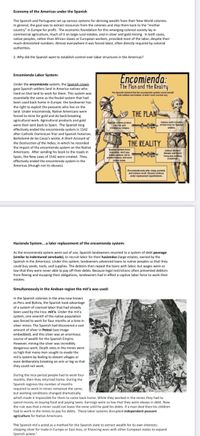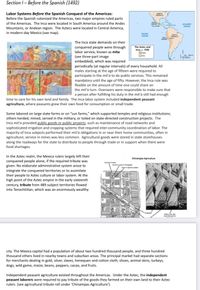Question
thumb_up100%
How were labor systems continuous before and after Iberian conquest?
How did labor systems change after Iberian Conquest?

Transcribed Image Text:Economy of the Americas under the Spanish
The Spanish and Portuguese set up various systems for deriving wealth from their New World colonies.
In general, the goal was to extract resources from the colonies and ship them back to the "mother
country" in Europe for profit. The economic foundation for this emerging colonial society lay in
commercial agriculture, much of it on large rural estates, and in silver and gold mining. In both cases,
native peoples, rather than African slaves or European workers, provided most of the labor, despite their
much-diminished numbers. Almost everywhere it was forced labor, often directly required by colonial
authorities.
2. Why did the Spanish want to establish control over labor structures in the Americas?
Encomienda:
The Plan and the Reality
Encomienda Labor System:
Under the encomienda system, the Spanish crown
gave Spanish settlers land in America natives who
lived on that land to work for them. This system was
The Spanish claimed that the encemienda system woid beneft
both settes and ndan twork out that way
essentially the same as the feudal system that had
been used back home in Europe: the landowner has
the right to exploit the peasants who live on the
land. Under encomienda, Native Americans were
forced to mine for gold and do back-breaking
agricultural work. Agricultural products and gold
were then sent back to Spain. The Spanish king
effectively ended the encomienda system in 1542
after Catholic Dominican friar and Spanish historian,
Bartolomé de las Casas's wrote, A Short Account of
the Destruction of the Indies, in which he recorded
the impact of the encomienda system on the Native
Americans. After sending his book to the royals in
Spain, the New Laws of 1542 were created. They
effectively ended the encomienda system in the
Americas (though not its abuses).
THE PLAN
wlers
Sparish ses protect
care for and
Chrisaniae nans.
Indians workponen
of their tie tor pah
seters
THE REALITY
Spanish setties force
Indians d
kgbor, dotper
an wrkes fal to
preect indians, and seie
Indan lands
disese and sh
ving and woring
cendo
Encomienda ends er clergy protests
and indians revot Abuses continue
under replacement repartiniento.
Hacienda System...a later replacement of the encomienda system:
As the encomienda system went out of use, Spanish landowners resorted to a system of debt peonage
(similar to indentured servitude), to recruit labor for their haciendas (large estates, owned by the
Spanish in the Americas). Under this system, landowners advanced loans to native peoples so that they
could buy seeds, tools, and supplies. The debtors then repaid the loans with labor, but wages were so
low that they were never able to pay off their debts. Because legal restrictions often prevented debtors
from fleeing and escaping their obligations, landowners had in effect a captive labor force to work their
estates.
Simultaneously in the Andean region the mit'a was used:
In the Spanish colonies in the area now known
as Peru and Bolivia, the Spanish took advantage
of a system of coerced labor that had already
been used by the Inca: mit'a. Under the mit'a
system, one seventh of the native population
was forced to work for four months at a time in
silver mines. The Spanish had discovered a vast
amount of silver in Potosi (see image
embedded), and this silver was an enormous
source of wealth for the Spanish Empire.
However, mining the silver was incredibly
dangerous work. Death rates in the mines were
so high that many men sought to evade the
mit'a system by feeling to distant villages or
even deliberately breaking an arm or leg so that
they could not work.
During the Inca period people had to work four
months, then they returned home. During the
Spanish regimes the number of months
required to work in mines remained the same,
but working conditions changed dramatically,
which made it impossible for them to come back home. While they worked in the mines they had to
spend money on buying food and paying taxes. Earnings were so low that they were always in debt. Now
the rule was that a miner could not leave the mine until he paid his debts. If a man died then his children
had to work in the mines to pay his debts. These labor systems disrupted independent peasant
agriculture for Native Americans.
The Spanish mit'a acted as a method for the Spanish state to extract wealth for its own interests:
shipping silver for trade in Europe or East Asia, or financing wars with other European states to expand
Spanish power.

Transcribed Image Text:Section I– Before the Spanish (1492)
Labor Systems Before the Spanish Conquest of the Americas:
Before the Spanish colonized the Americas, two major empires ruled parts
NORTH
AMERICA
of the Americas. The Inca were located in South America around the Andes
ATLANTIC
OCEAN
Cerb
Mountains, or Andean region. The Aztecs were located in Central America,
in modern-day Mexico (see map).
PACIFIC
OCEAN
SOUTH
AMERICA
EME
The Inca state demands on their
conquered people were through
labor service, known as mita
(see three-part image
embedded), which was required
periodically (at regular intervals) of every household. All
males starting at the age of fifteen were required to
participate in the mit'a to do public services. This remained
mandatory until the age of fifty. However, the Inca rule was
The Aztec and
Inca, c. 1500
flexible on the amount of time one could share on
the mit'a turn. Overseers were responsible to make sure that
a person after fulfilling his duty in the mit'a still had enough
time to care for his own land and family. The Inca labor system included independent peasant
agriculture, where peasants grew their own food for consumption or small trade.
Some labored on large state farms or on "sun farms," which supported temples and religious institutions;
others herded, mined, served in the military, or toiled on state-directed construction projects. The
Inca mit'a provided public goods or public projects, such as maintenance of road networks and
sophisticated irrigation and cropping systems that required inter-community coordination of labor. The
majority of Inca subjects performed their mit'a obligations in or near their home communities, often in
agriculture; service in mines was less common. Agricultural goods were stored in state storehouses
along the roadways for the state to distribute to people through trade or in support when there were
food shortages.
In the Aztec realm, the Mexica rulers largely left their
conquered people alone, if the required tribute was
given. No elaborate administrative system arose to
Chinampas Agrieulture
Famershoe
Oune e
Spanh aed
integrate the conquered territories or to assimilate
their people to Aztec culture or labor system. At the
high point of the Aztec empire in the early sixteenth
century, tribute from 489 subject territories flowed
into Tenochtitlan, which was an enormously wealthy
city. The Mexica capital had a population of about two hundred thousand people, and three hundred
thousand others lived in nearby towns and suburban areas. The principal market had separate sections
for merchants dealing in gold, silver, slaves, henequen and cotton cloth, shoes, animal skins, turkeys,
dogs, wild game, maize, beans, peppers, cacao, and fruits.
Independent peasant agriculture existed throughout the Americas. Under the Aztec, the independent
peasant laborers were required to pay tribute of the goods they farmed on their own land to their Aztec
rulers (see agricultural tribute roll under 'Chinampas Agriculture').
Expert Solution
This question has been solved!
Explore an expertly crafted, step-by-step solution for a thorough understanding of key concepts.
This is a popular solution
Trending nowThis is a popular solution!
Step by stepSolved in 2 steps
